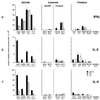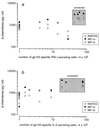beta-chemokines and neutralizing antibody titers correlate with sterilizing immunity generated in HIV-1 vaccinated macaques
- PMID: 9724785
- PMCID: PMC27976
- DOI: 10.1073/pnas.95.18.10803
beta-chemokines and neutralizing antibody titers correlate with sterilizing immunity generated in HIV-1 vaccinated macaques
Abstract
One of the obstacles to AIDS vaccine development is the variability of HIV-1 within individuals and within infected populations, enabling viral escape from highly specific vaccine induced immune responses. An understanding of the different immune mechanisms capable of inhibiting HIV infection may be of benefit in the eventual design of vaccines effective against HIV-1 variants. To study this we first compared the immune responses induced in Rhesus monkeys by using two different immunization strategies based on the same vaccine strain of HIV-1. We then utilized a chimeric simian/HIV that expressed the envelope of a dual tropic HIV-1 escape variant isolated from a later time point from the same patient from which the vaccine strain was isolated. Upon challenge, one vaccine group was completely protected from infection, whereas all of the other vaccinees and controls became infected. Protected macaques developed highest titers of heterologous neutralizing antibodies, and consistently elevated HIV-1-specific T helper responses. Furthermore, only protected animals had markedly increased concentrations of RANTES, macrophage inflammatory proteins 1alpha and 1beta produced by circulating CD8(+) T cells. These results suggest that vaccine strategies that induce multiple effector mechanisms in concert with beta-chemokines may be desired in the generation of protective immune responses by HIV-1 vaccines.
Figures




Similar articles
-
Combination Adenovirus and Protein Vaccines Prevent Infection or Reduce Viral Burden after Heterologous Clade C Simian-Human Immunodeficiency Virus Mucosal Challenge.J Virol. 2018 Jan 2;92(2):e01092-17. doi: 10.1128/JVI.01092-17. Print 2018 Jan 15. J Virol. 2018. PMID: 29093095 Free PMC article.
-
Evaluation of immune responses induced by HIV-1 gp120 in rhesus macaques: effect of vaccination on challenge with pathogenic strains of homologous and heterologous simian human immunodeficiency viruses.Virology. 2000 Aug 15;274(1):149-64. doi: 10.1006/viro.2000.0444. Virology. 2000. PMID: 10936096
-
High antibody and cellular responses induced to HIV-1 clade C envelope following DNA vaccines delivered by electroporation.Vaccine. 2011 Sep 9;29(39):6763-70. doi: 10.1016/j.vaccine.2010.12.055. Epub 2010 Dec 31. Vaccine. 2011. PMID: 21195801 Free PMC article.
-
Protection of neonatal macaques against experimental SHIV infection by human neutralizing monoclonal antibodies.Transfus Clin Biol. 2001 Aug;8(4):350-8. doi: 10.1016/s1246-7820(01)00187-2. Transfus Clin Biol. 2001. PMID: 11642027 Review.
-
A 30-year journey of trial and error towards a tolerogenic AIDS vaccine.Arch Virol. 2018 Aug;163(8):2025-2031. doi: 10.1007/s00705-018-3936-1. Epub 2018 Jul 24. Arch Virol. 2018. PMID: 30043201 Free PMC article. Review.
Cited by
-
Immune pathogenesis of pediatric HIV-1 infection.Curr HIV/AIDS Rep. 2006 Feb;3(1):13-9. doi: 10.1007/s11904-006-0003-4. Curr HIV/AIDS Rep. 2006. PMID: 16522254 Free PMC article. Review.
-
Characterization of neutralizing profiles in HIV-1 infected patients from whom the HJ16, HGN194 and HK20 mAbs were obtained.PLoS One. 2011;6(10):e25488. doi: 10.1371/journal.pone.0025488. Epub 2011 Oct 10. PLoS One. 2011. PMID: 22016769 Free PMC article.
-
Protection of rhesus monkeys against infection with minimally pathogenic simian-human immunodeficiency virus: correlations with neutralizing antibodies and cytotoxic T cells.J Virol. 2005 Mar;79(6):3358-69. doi: 10.1128/JVI.79.6.3358-3369.2005. J Virol. 2005. PMID: 15731230 Free PMC article.
-
Intravenous inoculation of replication-deficient recombinant vaccinia virus DIs expressing simian immunodeficiency virus gag controls highly pathogenic simian-human immunodeficiency virus in monkeys.J Virol. 2003 Dec;77(24):13248-56. doi: 10.1128/jvi.77.24.13248-13256.2003. J Virol. 2003. Retraction in: J Virol. 2005 Mar;79(5):3229. doi: 10.1128/JVI.79.5.3229.2005. PMID: 14645581 Free PMC article. Retracted.
-
Comparison of heterologous neutralizing antibody responses of human immunodeficiency virus type 1 (HIV-1)- and HIV-2-infected Senegalese patients: distinct patterns of breadth and magnitude distinguish HIV-1 and HIV-2 infections.J Virol. 2007 May;81(10):5331-8. doi: 10.1128/JVI.02789-06. Epub 2007 Feb 14. J Virol. 2007. PMID: 17301136 Free PMC article.
References
-
- Bloom B R. Science. 1996;272:1888–1890. - PubMed
-
- Haynes B F, Pantaleo G, Fauci A S. Science. 1996;271:324–328. - PubMed
-
- Heeney J L, Bruck C, Goudsmit J, Montagnier L, Schultz A, Tyrrell D, Zolla-Pazner S. Immunol Today. 1997;18:4–8. - PubMed
-
- Shearer G M, Clerici M. Immunol Today. 1996;17:21–24. - PubMed
-
- Heeney J L. AIDS. 1996;10:S115–S122. - PubMed
Publication types
MeSH terms
Substances
LinkOut - more resources
Full Text Sources
Other Literature Sources
Research Materials

